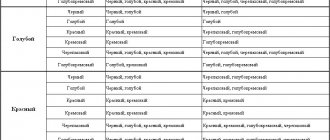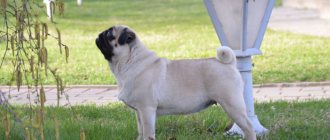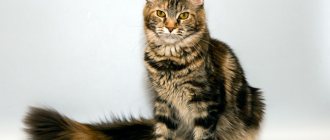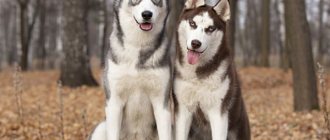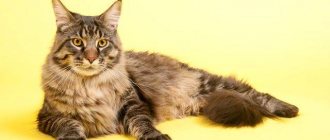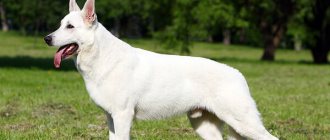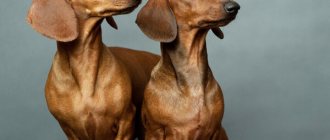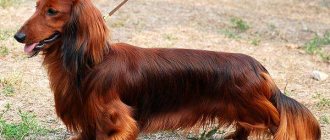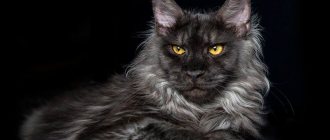To designate the “raccoon cat” standard, felinologists have adopted the EMS code system. Breeders study the genetic predisposition of pets to a certain color and fur pattern. The main names and their variations have been studied, depending on the tone, location of stripes and figures on the wool. The expected shade of the pet's eyes is known.
Principles for determining colors
Maine Coon coat color is determined by three elements:
- main type of wool;
- the presence of a pattern;
- the presence of spots, their shade and size.
In genetic terms, animal fur is colored only red or black. These colors are considered as basic; under the influence of hereditary and external factors they can become lighter or darker, essentially shades of primary colors. There is also a white color, which means the absence of pigment and in fact is not a color. White kittens usually have dark spots on their heads that gradually disappear with age.
How to take care of your Maine Coon's gray coat?
There is no doubt that the fluffy and thick fur of Maine Coons is one of their decorations. To ensure that your animal’s hair does not lose its shine, you should remember the following:
- For health in general and an attractive coat in particular, Maine Coons need proper nutrition. Dry or canned ready-made food labeled “for Maine Coons” (or “for large cats”) of super-premium quality (or holistic) is suitable as a diet. As an alternative to store-bought food, natural food is often chosen, which includes lean meat, cereals, vegetables (greens and fruits, if the cat likes them), and sour milk products. If the animal eats the food that the owner prepares for it, you will have to think about fortification. A lack of vitamins E and B always contributes to the deterioration of the coat;
- Almost any disease makes a luxurious fur coat faded and ugly. Stress, invasive diseases, poisoning, skin diseases are just some of the reasons why the fur looks untidy. To understand that an animal is unhealthy, sometimes it is enough to look at its fur;
- Maine Coons are naturally clean cats, so you shouldn’t bathe them often. As a rule, bath procedures are carried out once every 3-6 months using a special shampoo for long-haired cats, after which the pets are dried with towels and a hairdryer. Show cats are bathed more often, before each appearance. In this case, not only cleansing shampoo is used, but also coloring, degreasing and texturizing grooming products;
- Domestic gray Maine Coons are brushed two to three times a week, and daily during shedding. For the fur on the body, brushes with long teeth are used, for the face and limbs - with short ones. Sometimes they do it differently: first they comb the cat with a brush with sparse teeth, and then with frequent ones. It’s hardly worth neglecting combing, because thick fur will quickly form tangles that will simply have to be cut out, depriving the animal of hair growth;
- During shedding, gray Maine Coons lose hair no less than other long-haired cats. Typically, the fur begins to shed twice a year, usually in early spring and late summer or fall. If the air in the room is too dry, shedding may be prolonged. To prevent the animal from swallowing hair during active hair loss, it makes sense not to neglect combing. And if necessary, you can give the cat a special product - a paste or gel for removing hairballs;
- Sometimes handsome Maine Coons are taken to a grooming salon for a haircut (usually the hair on the body is shortened). On the one hand, after a haircut, it is easier for an animal to survive the heat (especially if there are no cooling devices in the apartment). And the owner has less worries in the form of lengthy combing. However, almost all owners who have carried out a similar procedure at least once note that the new coat that grows is of poorer quality: thinner and more prone to tangling. It turns out that it is better to remove dead hairs with a regular brush, without depriving the Maine Coon of his thick and beautiful coat.
EMS classification
To simplify the names for entering information into documentation, they created the EMS system (stands for Easy Mind System). A special complex for encoding shades and patterns, and other parameters, allows you to reflect all the nuances in letter and number combinations.
Each coat color received its own Latin letter designation:
- n – black, one of the primary colors.
- a – blue, this color appears after the black color is lightened.
- d – red – the second primary color of animals.
- e – cream, appears when red is lightened.
- f - tortoiseshell - characteristic of cats, but practically never found in cats, tortoiseshell color looks like a unique combination of black and red, which is never duplicated, like human fingerprints.
- g – creamy blue tortoiseshell appears as a result of lightening the usual color in a tortoiseshell combination.
- w – white, although it is essentially not a color, but its absence. If a cat has at least one spot of a different color, it is no longer white.
According to the breed standard, certain shades of coat are not allowed: sorrel and lilac, fawn and chocolate, gold and cinnamon. The same applies to unrecognized tortoiseshell colors: lilac and fawn, blue and cinnamon, and some others.
White color
There are digital codes for the white color in an animal's coloration. The lower the indicator, the higher the percentage of white wool:
- 01 – van (van) – the coat is almost completely white, but there are two colored spots on the head, the tail is a different color. There is also a small spot at the shoulders.
- 02 – harlequin – differs from the previous type by the presence of several multi-colored spots of different sizes on the back.
- 03 – bicolor – white wool accounts for half of the total mass.
- 09 – the presence of white (unspecified amound of white) – the color is present on the paws, on the chest.
The color with a white spot on the chest is called a medallion, with one or more clear spots - buttons. The white bottom of the paws is known as gloves, and their combination with the medallion and dark color of the back is known as a tuxedo. All other codes for spotting with white belong to other cat breeds.
Eyes and their color
Maine Coon eye colors are usually not taken into account in the EMS code, but some eye color combinations have their own names and coding:
- Tin is a silver marbled black cat with orange eyes.
- Silver is the same color, but combined with green eyes.
- The odd-eyed Maine Coon receives the code w 63.
A white Maine Coon with blue eyes is usually deaf because the amount of pigment in the body is related to the development of the hearing system.
Color varieties: tabby
Based on their color, all Maine Coons are divided into several categories:
- Striped type (“Tabby”).
- Monochromatic color (“Solid”).
- Smoky shades (“Smoke”).
- Turtle coloring pages.
- Marble.
- White spots.
- Random color combination.
Tabby is considered the original color of wild cats. Tabby Maine Coons have thin lines on their faces that form the letter M on their forehead. Each hair is colored with both light and dark stripes, this type of alternation is called “agouti”.
Tabby coloring can be:
- Brindle or Mackerel - stripes running vertically and parallel.
- Classic (Classic or blotched) - large width stripes on the sides in the form of a spiral, similar to marble patterns.
- Spotted or Spotted - there are intermittent stripes across the entire surface of the body, forming spots.
- Ticked (Ticked or Abyssinian) - there are no stripes or spots on the body, but there is a pattern on the muzzle, and agouti runs along the body. This color is not recognized as part of the Maine Coon breed.
The color of a tabby is determined by the color of the tip of the tail or stripes. A certain digital classification is provided for the drawing. 22 is marbled, 23 is dashed or “mackerel”, 24 is spotted, 25 is ticked. Sometimes the number 21 indicates a fuzzy pattern.
The basic rule here is simple: the larger the picture, the smaller the number by which it is designated. The most popular animals are the colors black and red tabby marble.
Solid color
The solid solid color appeared in the process of suppressing the recessive tabby genes. Sometimes a fuzzy shadow pattern remains, which is called shadow. Solid color is a uniform, rich coat color throughout the body with hair coloring from the base to the very tip. Residual patterns and light undercoat are considered a fault, and marks of a different color are considered defective.
The color of solids can be black or red, white or blue, sometimes cream. The black Maine Coon looks very beautiful, but requires more frequent brushing than cats of other colors. This is necessary to renew the coat and remove dead brown hairs, especially during shedding. Proper nutrition also plays an important role.
The black and white Maine Coon (black with a white spot) belongs to the bicolor class.
In the red color it is difficult to achieve the absence of a pattern, since the tabby gene is very strong. Cats of this color are often called red Maine Coons; they almost always have a slight pattern.
The blue solid color is rare. The color of the fur of these animals is gray with an ashy and even slightly bluish color. Cream Maine Coons are produced by lightening the red color and have a ginger-tinged coat.
Tortoiseshell colors
The tortoiseshell color with black is called torbi (torbi) in combination with brownish and red, torti (torti) - with a cream component. The classic tortoiseshell color is called blue-cream. With this coloring, white markings sometimes appear. Other names are blue tortie or dilute tortie. The name of the color with inserts of cream and blue shades is blue patched tabby.
A color with white spots that have clear boundaries is called calico. Coloring with cream color and splashes of blue - dilute calico. For an arbitrary volume of white there is a name patched tabby and white. The black marbled cat is also called a forest cat, because in color it resembles its wild ancestor.
The spots can be an independent part of the color or complement the stripes. Such elements appear in the form of lightened back of the ears, darkened surroundings of the nose and eyes, shaded stripes on the cheeks, a necklace on the neck, bracelets on the limbs, and buttons on the abdomen.
Silver and smoky shades
Cats of silver or smoky colors look very impressive. Silver is a practical white coat with an undercoat closer to the skin by a third of the length. Immediately after birth, kittens appear white, but have green eyes. Cream animals are also born white, with a haze of cream color appearing gradually. This shade has its own letter designation –s (means silver). When the colored wool is plain, without a pattern, the same letter in the code means “smoky” (translated as smoke).
The result is the following encodings:
- ns – black smoke;
- as – blue smoke;
- ds – red smoke;
- es – creamy smoke;
- fs – turtle smoke;
- gs – blue cream tortoiseshell smoke.
For genetic reasons, the ws combination does not exist.
Based on the length of the dyed hairs, they can be classified as smoky (colored on half the length), shaded (colored on 1/4), and chinchilla (saturated color on an eighth of the hair).
A random combination of shades means a color that includes several shades, but without white inclusions. These are brown spotted tabby, creamy blue and blue spotted. Any solid color is considered a rare color. Getting this option is difficult, and keeping it is even more difficult. A rare occurrence is the birth of a solid-colored animal from parents who have any pattern on their fur.
In the photo: Maine Coon color ds – red smoke
Rare colors
The rarest colors include solid colors of Maine Coons of any color. Breeders obtain an even, uniformly colored tone through their work with pets. Color options accepted by the American and European breed standard systems are considered valuable. It is not often that a baby is born with a uniform coat from parents with spots and stripes on the coat. Rare ones also include the presence of a tricolor color in cats.
Maine Coon Facts What Maine Coons Eat
The colors of Maine Coons depend on the genetic predisposition of the pet and on the painstaking work of breeders. The colors of a kitten's fur coat differ from the color of the coat of an adult pet. Since over time, in some representatives of the color, the stripes and spots become blurred and are of a residual nature. When looking for a purebred animal of a certain color to take home, you should seek recommendations from nursery owners.
Determining the color of future offspring
To determine what color will be obtained when crossing animals of a certain color, a special color table is used. There are also special color calculators on the Internet that automatically calculate the color of future offspring. To do this you need to specify:
- presence of silver, white spots;
- EMS breed coding;
- main color;
- drawing;
- gender of both parent animals.
By the way, the gender of the animal is also coded. The cat is designated by the numbers 1.0, the cat is assigned the code 0.1.
In general, the health of Maine Coons has no connection with color, but there are exceptions. So, you cannot cross white individuals.
The colors of Maine Coon cats come in a wide range of colors. Amazing combinations of patterns and colors, stripes and spots give their magnificent wool a special sophistication and original appearance. The color of the Maine Coon to a certain extent determines the price, but is not the determining factor. To breed good offspring, the more important parameter is the breed type of the cat and its health status.
What colors are considered the most expensive and respectable?
The fashion for the color of cats changes over the years. Either red marble soars in price, or Harlequin. Colors can be truly rare and original. But the value of animals is not in them, but in their health and breed characteristics.
A cat is a friend, a family member. It doesn't matter what his fur is. They choose a friend with their hearts and for a long time, and the colors are all good in their own way.
Cheaply choose and acquire a friend in the Lakiss nursery, Novosibirsk. For example, a black marble male kitten costs 5,000 rubles.*
Kittens are delivered to any city in Russia and abroad by the AKBARS nursery in the city of Ufa. They are purebred with passports and pedigree. The average price is 15 thousand rubles.
Character traits and level of intelligence
The character and habits of the Maine Coon are often described as dog-like. Smart and quick-witted animals, they have a soft character and playfulness. They are quite sociable and have nothing against children and other animals. The owners choose one family member for themselves, having a special affection for him.
They are not demanding, although they love to be the center of attention. Sometimes this manifests itself in excessive intrusiveness - Maines try to occupy the owner’s bed, greet him and guests in the hallway, and allow strangers to caress them. At the same time, females are more cautious and restrained than males.
These cats are surprisingly easy to adapt to any conditions and surroundings.
You can often find a large Maine Coon cat trying to catch drops falling from a tap or diligently “helping” its owner wash the dishes - these cats have a strange passion for water.
On a walk
With white markings
White markings, clearly defined (as opposed to the shaded spots of the Siamese) can be present on any color. You just need to add “With white (and white)” to the description of the main color. So, for example, you get “Black and White” or “Cream and White”.
The white areas may vary in size and location, and the most accurate name for the color depends on this:
With white medallion (locket)
- There is a white spot on the chest.
With white gloves (mitted)
– white slippers on the paws.
With white buttons
– the presence of one or more small white spots.
Bicolor (bi-color)
– half white.
Harlequin
- white with several large colored spots.
Van
- all white with color on the tail and head.
Tuxedo (tuxedo)
- white paws and chest. May have some white on head. This definition is informal.
Van
Harlequin
Bi-color
Tuxedo (Tuxedo)
With white medallion (Locket)
With white gloves (Mitted)
Tortoiseshell
The tortoiseshell Maine Coon comes in two types – torby and torty.
The first type is a combination of red and black shades of wool, expressed in a dark brown color. The torti has a greater addition of red with dark cream. Of particular interest is the fact that tortoiseshell coloring is most often found in cats.
The probability of a male being born with this coloring is approximately 1 in 1000.
On such cats, markings of different sizes and shapes are more clearly visible. Based on the severity of these spots, several colors can be distinguished:
- calico;
- flap;
- chintz.
These cats are characterized by the presence of red shades of fur. The classic color, consisting of three colors, is obtained by mixing black and red. This makes the coat more variegated. There are also several tortoiseshell shades.
Scaly tortoiseshell
Reminiscent of fish scales, the order of spots on the body is checkerboard. These spots alternate in black and red tones and are unevenly distributed. Any one of the colors may predominate.
Calico and solid tortoiseshell (patchwork)
The spots of black and red color resemble flaps. They have defined boundaries and can overlap each other. If the wool has white patches, this color is called “tortoiseshell white” or calico. Red and black spots are solid in color and clearly visible on the animal’s body.
Patterned tortoiseshell
Multi-colored spots have a pronounced pattern. These may be spots or stripes, but marbled colors are also common. There may be small white spots. In this case, it is fashionable to say that the color is spotted tabby or tabby with white spots.
